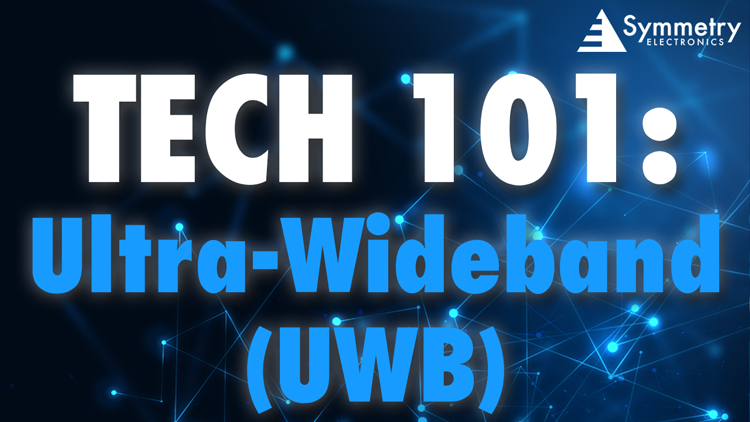- Home
- Symmetry Blog
- Tech 101: Ultra-Wideband (UWB) | Symmetry Blog
Tech 101: Ultra-Wideband (UWB) | Symmetry Blog
About Savannah Cuthbert

Ultra-wideband (UWB), previously named “pulse radio”, is a low power, short range, and high bandwidth wireless communication protocol. Originally used for military radar and medical imaging, UWB is now being used primarily for device-to-device communication and real-time location systems (RTLS) in indoor commercial applications.
Ultra-Wideband Key Features
UWB offers robust spatial awareness and location tracking between UWB-enabled devices, with the ability to collect and communicate mass amounts of data (due to high bandwidth operation of >500 MHz). Operating at a low power level (0.5 mW / -41.3 dBm/MHz), ultra-wideband can effectively transmit information without interference from conventional narrowband or carrier wave transmissions that operate in the same frequency band.
UWB vs. Bluetooth vs. Wi-Fi
Bluetooth and Wi-Fi are often used for similar RTLS indoor use cases. However, UWB offers a series of benefits that make it the ideal option for precise indoor location discovery and device ranging. Ultra-wideband operates by continuously scanning a room for UWB-enabled devices. Once a device is identified, location data is captured and the distance between devices is calculated–offering 10-30 cm of accuracy. One disadvantage of ultra-wideband in comparison to Wi-Fi, is its inability to penetrate walls or other physical structures, due to its short-range functionality. However, UWB is paramount to Bluetooth and Wi-Fi in the following ways:
- More precise
- Lower power
- Higher security
Ultra-Wideband Applications
Apple was the first company to introduce UWB capabilities to the smartphone industry, with the launch of their UWB-enabled iPhone 11 in September 2019. The use of ultra-wideband has allowed for a more precise and secure transfer of data when using their AirDrop feature. Apple also patented the use of UWB in conjunction with their iBeacon technology to support more precise spatial awareness when monitoring the presence of UWB-enabled devices such as smart phones and smart watches that come within close range of a beacon sensor. Beacons are most commonly used in retail shops, airports or manufacturing facilities to track the location/proximity of devices and deliver actionable insights such as the following:
- Potential consumer product interest
- Tailored consumer retail or airport map navigation
- Manufacturing facility asset tracking and tailored procedures
FiRa Consortium Expands UWB Ecosystem
The FiRa (fine ranging) Consortium, consisting of major corporate players such as Sony, Samsung, Bosch, NXP, Qorvo, and more, have developed an organization that is focused on growing an ecosystem of interoperable UWB technologies. The three main use cases they are focused on apply to smart home, smart city, smart retail and smart building/industrial applications, which include:
- Hands-free access control
- Location-based services
- Device-to-device applications
Interested in developing an UWB-enabled technology of your own? Our Applications Engineers offer free design and technical support for your latest designs. Contact us today!
References
https://www.firaconsortium.org/discover/use-cases
